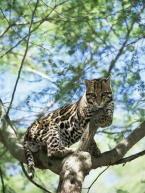Ocelot
Behavior/Activities
Ocelots are nocturnal mammals (awake in the night) that can travel a big distance. They can travel from 1- 5 miles, and capture an average of one prey every 3.1 hours of traveling. Male ocelots frequently travel farther than females. An amazing fact is that it can shadow monkeys and birds in trees with their adequate climbing skills ( 0:34 - 1:10 in video ) . It relaxes in trees, hollows of a tree, thick brush, and has its own private home (unless with a mate) that can be as big as 25 sq. miles for males and 9 sq. miles for females because it is very solitary. Sometimes different genders will allow overlapping. Like most animals, they mark territory with a scent mark. Some examples of this are the spraying of urine ( 2:19- 2:45 in video ), dropping feces in noticeable places, and scraping the ground with their hind feet.
When hunting, ocelots get at a close range and attack. They can move inaudibly and speedily in the undergrowth.
Some scent marks tell if a female ocelot is ready for mating, and it can communicate vocally too.
When hunting, ocelots get at a close range and attack. They can move inaudibly and speedily in the undergrowth.
Some scent marks tell if a female ocelot is ready for mating, and it can communicate vocally too.
Symbiotic Relationship
The only symbiotic relationship between an ocelot and another organism is the plant near to its prey. It can use the plant to hide itself because it lives in dense underbrush, and the remains of the prey will decompose give the plant nutrients. This type of symbiotic relationship is called mutualism, where both are benefited.


